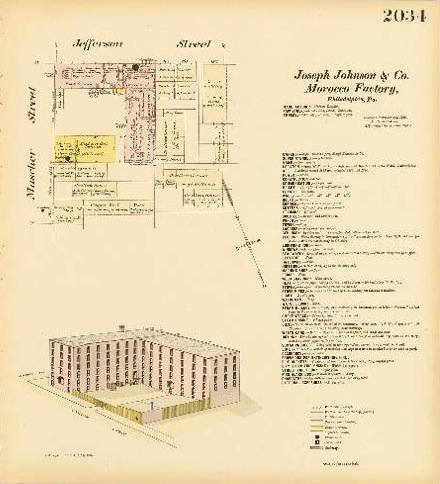
"Joseph Johnson & Co., Morocco Factory" (1886), Hexamer #2034.
Joseph Johnson and Company, Morocco Factory, 1875
153 West Jefferson Street, Philadelphia PA 19122
(northwest corner of Mascher Street)
© Carmen A. Weber, Irving
Kosmin, and Muriel Kirkpatrick, Workshop of the World (Oliver
Evans Press, 1990).
Built in 1875, first owned by
Joseph Hacker, this factory is across the street from
what was Delaney's Curled Hair and Glue Works
1
, which would
have supplied most of the raw material needed for
leather-making. In 1880 Joseph Johnson, the owner in
1886, was listed as working at J. Hacker's.
2
The brick
building survives in the form it took in 1886 when it was
extended, probably by the addition of the ell on the west
side. On the upper stories, casement windows have
replaced the original louvers, some of these floors were
used for drying the leather by "atmospheric air."
3
The lower windows
are arched with six-over-six panes and the building still
retains wooden sills.
Morocco leather is made from goatskin, it is tougher than
sheep or cow skin, and its denser texture makes it more
suitable for being worked into a variety of products. To
produce the distinctive red Morocco color, the untanned
but cured leather is soaked in a dye made from dried
insects. 4
In the Johnson Morocco factory the lime vats, which
loosen the hair and start the curing, were in the yard
off Mascher Street, the hides were beamed, or scraped, in
the basement of the building facing Jefferson, tanned
with sumac and colored in the ell, finished, bevelled,
and dried. Sperm oil was used on the stock, probably to
curry the skins. This factory employed forty men, twelve
boys, and three girls.
Operations in the Johnson factory were much less
extensive than in William Schollenberger and Sons Morocco
Factory one block north on Mascher. A number of Hexamer
surveys for this site showed how it developed from a
leather and tallow works. 5
Buildings on
earlier surveys had vats for rendering tallow, and
Schollenberger worked with sheep and calf skin as well as
with goat; he had a bark tannery in addition to sumac. By
1879 6
he was no longer
making tallow and had rented space to yarn and weaving
manufacturers, as well as to Thomas Dolan, whose mills
were to the west and south of him. Perhaps Schollenberger
had discovered the profits in producing only Morocco
leather.
Atlases from 1888 and 1895 continued to associate Joseph
Johnson with the factory at Jefferson and Mascher.
7
The Johnson Lamp
Factory was here from 1910 to 1916, 8
but it is not
known whether this was the same owner with a change of
industry. In 1945 9
a machine shop
was marked on the atlas and today it is occupied by
Haupt's Funeral Supplies, which began as early as
1943. 10
1 Hexamer General Survey #1088 (1887),
"Delaney's Curled Hair and Glue
Works."
2 J. Gopsill,
Gopsill's Philadelphia Business Directory,
(Philadelphia, 1880).
3 Hexamer General Survey #2034 (1886),
"Joseph Johnson & Co., Morocco
Factory."
4 Charles C.
Gillispie, ed., A Diderot Pictorial Encyclopedia of
Trades and Industry, Volume 2, Selected from
"L'Encyclopedie, ou Dictionnaire Raissonne des
Sciences, des Arts, et des Metiers," edited by Charles
C. Gillispie, (New York, 1959), Pls. 396, and 339.
5 Hexamer General Survey
#349
Hexamer General Survey #520 "William
Schollenberger, Morocco Manufactory & Tallow
Works."
Hexamer General Survey #1335 (1879), "Wm.
Schollenberger & Sons, Morocco
Factory."
6 Hexamer General Survey #1335 (1879), "Wm.
Schollenberger & Sons, Morocco
Factory."
7 Bromley, 1895; and
Elvino V. Smith, Atlas of the 11th, 12th, 13th, 14th,
15th, 16th, and 17th Wards of the City of
Philadelphia, (Philadelphia, 1909).
8 Bromley, 1910; and
1916.
9 Sanborn Map Company,
1945.
10 Chamber of Commerce
and Board of Trade 1944, p. 108.
Update May
2007 (by
Torben Jenk):
Converted to apartments. Many first-floor window openings
have been sealed with concrete block. Windows above have
been replaced.